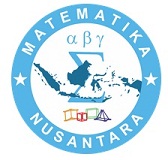Analisis Kesulitan Siswa Berdasarkan Kemampuan Berpikir Kreatif Matematis dalam Menyelesaikan Soal Bangun Ruang
Abstract
Full Text:
PDFReferences
Andiyana, M. A., Maya, R., & Hidayat, W. (2018). Analisis Kemampuan Berpikir Kreatif Matematis Siswa SMP Pada Materi Bangun Ruang. JPMI (Jurnal Pembelajaran Matematika Inovatif), 1(4), 779. https://doi.org/10.22460/jpmi.v1i3.239-248
Arifah, A. N., & Retnawati, H. (2020). Are students having trouble solving problems polyhedron? Journal of Physics: Conference Series, 1613(1), 1–9. https://doi.org/10.1088/1742-6596/1613/1/012029
Elfiah, N. S., Maharani, H. R., & Aminudin, M. (2020). Hambatan Epistemologi Siswa Dalam Menyelesaikan Masalah Bangun Ruang Sisi Datar. Delta: Jurnal Ilmiah Pendidikan Matematika, 8(1), 11–22. https://doi.org/10.31941/delta.v8i1.887
Ferdiani, R. D., Farida, N., & Murniasih, T. R. (2019). Analisis Kemampuan Berpikir Kreatif Siswa SMP Melalui Soal Open Ended pada Materi Bangun Tabung. MUST: Journal of Mathematics Education, Science and Technology, 4(1), 35. https://doi.org/10.30651/must.v4i1.2595
Firdausi, Y. N., Asikin, M., & Wuryanto. (2018). Analisis Kemampuan Berpikir Kreatif Siswa Ditinjau dari Gaya Belajar pada Pembelajaran Model Eliciting Activities ( MEA ). PRISMA, Prosiding Seminar Nasional Matematika, 1, 239–247. https://doi.org/https://journal.unnes.ac.id/sju/index.php/prisma/article/view/19582
Hasibuan, E. K. (2018). Analisis Kesulitan Belajar Matematika Siswa Pada Pokok Bahasan Bangun Ruang Sisi Datar Di Smp Negeri 12 Bandung. AXIOM, 7(1), 18–30. https://doi.org/10.30821/axiom.v7i1.1766
Huang, P. S., Peng, S. L., Chen, H. C., Tseng, L. C., & Hsu, L. C. (2017). The relative influences of domain knowledge and domain-general divergent thinking on scientific creativity and mathematical creativity. Thinking Skills and Creativity, 25, 4–20. https://doi.org/10.1016/j.tsc.2017.06.001
Junaedi, Y., Wahyudin, & Juandi, D. (2021). Mathematical creative thinking ability of junior high school students’ on polyhedron. Journal of Physics: Conference Series, 1806(1). https://doi.org/10.1088/1742-6596/1806/1/012069
Lestari, D. T., Rohaeti, E. E., & Senjayawati, E. (2019). Analisis kesulitan belajar siswa SMP kelas VIII dalam menyelesaikan soal aritmatika ditinjau dari kemampuan komunikasi matematis. Journal On Education, 1(2), 440–444.
Mullis, I.V.S, Martin, M. O., & Foy, P. (2008). TIMSS 2007 International Mathematics Report: Findings from IEA’s Trends in International Mathematics and Science Study at The Fourth and Eighth Grades. In TIMSS & PIRLS International Study Center. TIMSS & PIRLS International Study Center, Boston College. http://isc.bc.edu/timss2003i/mathD.html
Mullis, I.V.S, Martin, M. O., Foy, P., & Arora, A. (2012). Timss 2011 International Results in Mathematics. In T. & P. I. S. Center & B. C. Lynch School of Education (Eds.), TIMSS & PIRLS International Study Center (Vol. 2012, Issue 136). http://www.pubmedcentral.nih.gov/articlerender.fcgi?artid=3295935&tool=pmcentrez&rendertype=abstract
Mullis, Ina V.S., Martin, M. O., Foy, P., & Hoopeer, M. (2015). Timss 2015 International Results in Mathematics. In IEA TIMSS & PIRLS. International Study Center. https://doi.org/timss2015.org/download-center
Mulyani, M., & Muhtadi, D. (2019). Analisis Kesalahan Siswa Dalam Menyelesaikan Soal Trigonometri Tipe Higher Order Thinking Skill Ditinjau Dari Gender. Jurnal Penelitian Dan Pembelajaran Matematika, 12(1), 1–16. https://doi.org/10.30870/jppm.v12i1.4851
Novianti, M., Zubaidah, R., & Hamdani. (2017). Pengaruh Pendekatan Open-Ended terhadap Kemampuan Berpikir Kreatif Siswa Sekolah Menengah Pertama. Jurnal Pendidikan Dan Pembelajaran Khatulistiwa, 6(2), 1–10.
Nugraha, N., Kadarisma, G., & Setiawan, W. (2019). Analisis Kesulitan Belajar Matematika Materi Bentuk Aljabar pada Siswa SMP Kelas VII. Journal On Education, 01(02), 323–334.
Putri, I. W. S., Trapsilasiwi, D., Hobri, H., Oktavianingtyas, E., Safrida, L. N., & Aini, N. (2019). Creative thinking skill with adversity quotient based on lesson study for learning community. Journal of Physics, 1–8. https://doi.org/10.1088/1742-6596/1211/1/012110
Putridayani, I. B., & Chotimah, S. (2020). Analisis Kesulitan Belajar Siswa Dalam Pelajaran Matematika Pada Materi Peluang. Maju, 7(1), 57–62.
Ramdani, M., & Apriansyah, D. (2018). Analisis Kemampuan Pemahaman dan Berpikir Kreatif Matematika Siswa MTS Pada Materi Bangun Ruang Sisi Datar. Jurnal Cendekia : Jurnal Pendidikan Matematika, 2(2), 1–7. https://doi.org/10.31004/cendekia.v2i2.46
Rittle-Johnson, B., Schneider, M., & Star, J. R. (2015). Not a One-Way Street: Bidirectional Relations Between Procedural and Conceptual Knowledge of Mathematics. Educational Psychology Review, 27(4), 587–597. https://doi.org/10.1007/s10648-015-9302-x
Ruswati, D., Utami, W. T., & Senjayawati, E. (2018). Analisis kesalahan siswa smp dalam menyelesaikan soal kemampuan pemecahan masalah matematis ditinjau dari tiga aspek. Jurnal MAJU, 5(1), 91–107. https://doi.org/https://doi.org/10.1590/s1809- 98232013000400007
Suciati, I., & Wahyuni, D. S. (2018). Analisis Kesalahan Siswa dalam Menyelesaikan Soal Matematika pada Operasi Hitung Pecahan pada Siswa Kelas V SDN Pengawu. Jurnal Penelitian Dan Pembelajaran Matematika, 11(2), 129–144. https://doi.org/http://dx.doi.org/10.30870/jppm.v11i2.3760
Yadrika, G., Amelia, S., Roza, Y., & Maimunah. (2019). Analisis Kesalahan Siswa SMP Dalam Menyelesaikan Soal Pada Materi Teorema Pythagoras Dan Lingkaran. Jurnal Penelitian Dan Pembelajaran Matematika, 12(2), 195–212. https://doi.org/http://dx.doi.org/10.30870/jppm.v12i2.6157
Yuniarti, Y., Kusumah, Y. S., Suryadi, D., & Bana, G. (2017). The Effectiveness of Open-Ended Problems Based Analytic-Synthetic Learning on the Mathematical Creative Thinking Ability of Pre-Service Elementary School Teachers. International Electronic Journal of Mathematics Education (IEJME-Mathematic Education), 12(7), 656–666.
DOI: http://dx.doi.org/10.30870/jppm.v14i2.11807
Refbacks
- There are currently no refbacks.
Copyright (c) 2021 JPPM (Jurnal Penelitian dan Pembelajaran Matematika)
Ciptaan disebarluaskan di bawah Lisensi Creative Commons Atribusi 4.0 Internasional .
JPPM (Jurnal Penelitian dan Pembelajaran Matematika). Jurnal ini diterbitkan oleh Jurusan Pendidikan Matematika FKIP Universitas Sultan Ageng Tirtayasa (cetak) dan Jurnal Untirta (eprint).
Alamat Penerbit: Jl. Raya Ciwaru No 25 Kota Serang Banten, Jurusan Pendidikan Matematika, Fakultas Keguruan dan Ilmu Pendidikan, Universitas Sultan Ageng Tirtayasa, Kampus Ciwaru, Serang, Banten, Indonesia. Telepon / Faks: (0254) 280330 Ext 111, Email: [email protected] |Klik untuk mengakses: Jurnal Penelitian dan Pembelajaran Matematika


